Methods of Inquiry
The archaeological investigation of Atripe has involved an interdisciplinary collaboration with a German-Egyptian project sponsored by the University of Tübingen.
The relatively late development of archaeological interest in Atripe’s Christian period, over a century after Petrie’s excavations and several years into the work of the German-Egyptian project, meant that there was a lot of new information available for study (fig. 1).[1] In analyzing these data, the YMAP-South team has employed a wide range of techniques from different specialist disciplines (digital archaeology, manual archaeology, epigraphy, etc.).
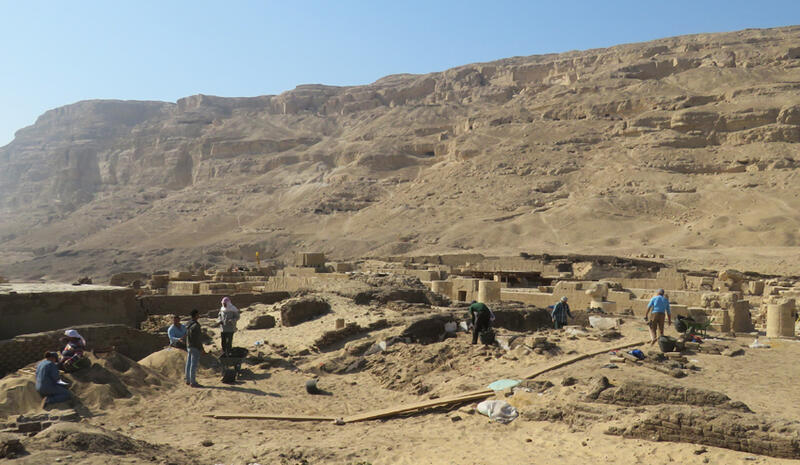
Figure 1. Excavation of the Six-Pillared Hall in progress in 2017, against the backdrop of Atripe’s limestone cliffs.
Digital archaeological techniques were employed for topographic survey, the development of a photo-realistic 3D model, and the documentation of epigraphic materials (fig. 2). A Geographic Information System (GIS) was generated to capture, store, manage and display topographic and spatial information.[2] Using photogrammetric techniques based on the Structure from Motion (SfM) algorithm, we recorded the entire area of the temple and its periphery in 3D and combined them into a single photorealistic model.[3] The 3D model has allowed the mapping of the monastic adaptive reuse of this structure, as well as purpose-built additions around its perimeter. It also stores these data and additional materials from earlier excavations, from Remote Sensing, and from other sources as a digital archive.
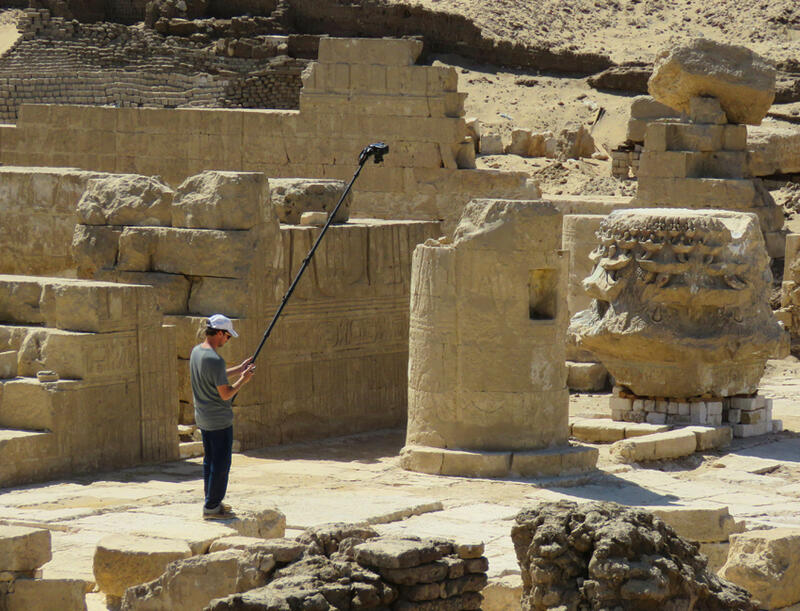
Figure 2. Structure from Motion recording using a telescopic pole and Wi-Fi-controlled camera by Alberto Urcia in 2016.
The same digital technique was employed to document the progress of work in YMAP-South’s excavation of the Six-Pillared Hall. Scaled ortho-images (i.e. face-on and plan views) were also produced to support the documentation of this and other early Christian architectural spaces. The digital enhancement of written materials through RGB colour manipulation (DStretch) was an essential component of the study of the epigraphic recording and was particularly effective for wall writings (dipinti) in red or green pigment (fig. 3).[4]
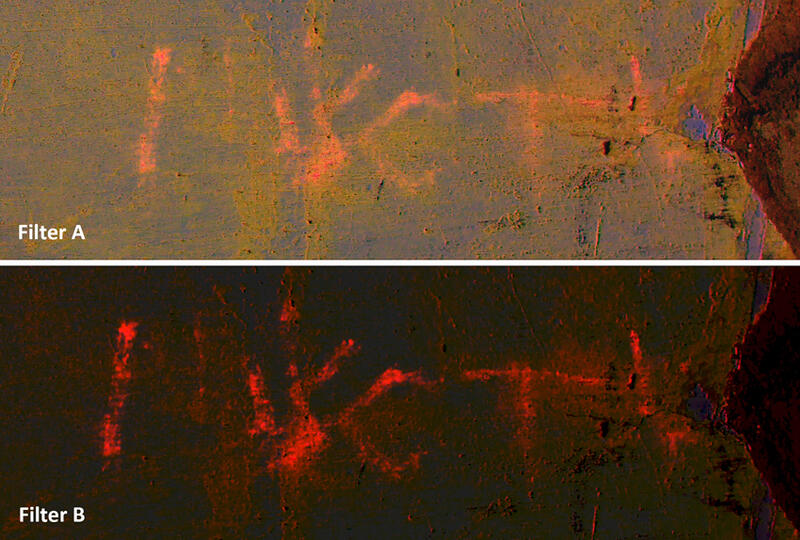
Figure 3. Digital manipulation of a red-painted dipinto using digital technology.
Manual archaeological techniques and a single-context method were employed for excavation.[5] This approach facilitated the characterization of the deposits, cuts, and architectural features through written descriptions (fig. 4), scaled plans and wall elevations, photo-documentation, photogrammetry, and a stratigraphic matrix. The rich variety of excavated materials (pottery, glass, objects, bones, and plants) became the subject of specialist study, each with its own methods. In recording already-excavated spaces, which typically lack deposits and associated items of material culture, the YMAP-South archaeologists utilized a modified version of the system developed by Louise Blanke at the White Monastery.[6]
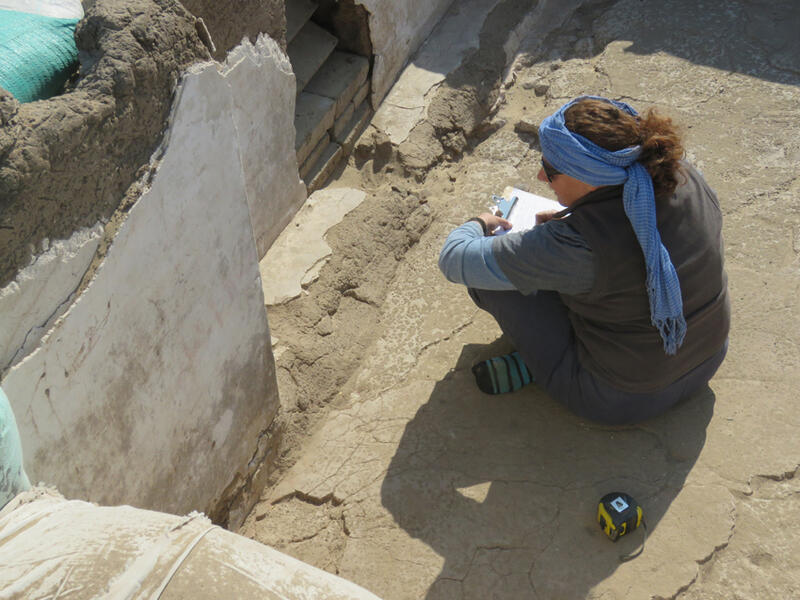
Figure 4. Wendy Dolling Recording architecture during the excavation of the Six-Pillared Hall in 2017.
Pottery and glass were recorded using both quantitative and qualitative methods (i.e. the counting and describing of objects), as well as technical drawings and photo-documentation (figs. 5–6). These different techniques facilitated the development of typological catalogues representative of activities within particular spaces and more broadly throughout Christian Atripe.[7] The different clay mixes used within the ceramic assemblage were defined as a fabric series. Petrographic analysis of these fabrics investigated the mineral inclusions indicative of the clay’s geological origin, technological properties, and firing temperature.[8] Written and visual recording tools were also used in the specialist study of objects.[9] These often fragmentary, lost, or discarded items of material culture provided further texture to YMAP-South’s understanding of localized activities and their cultural and temporal setting.
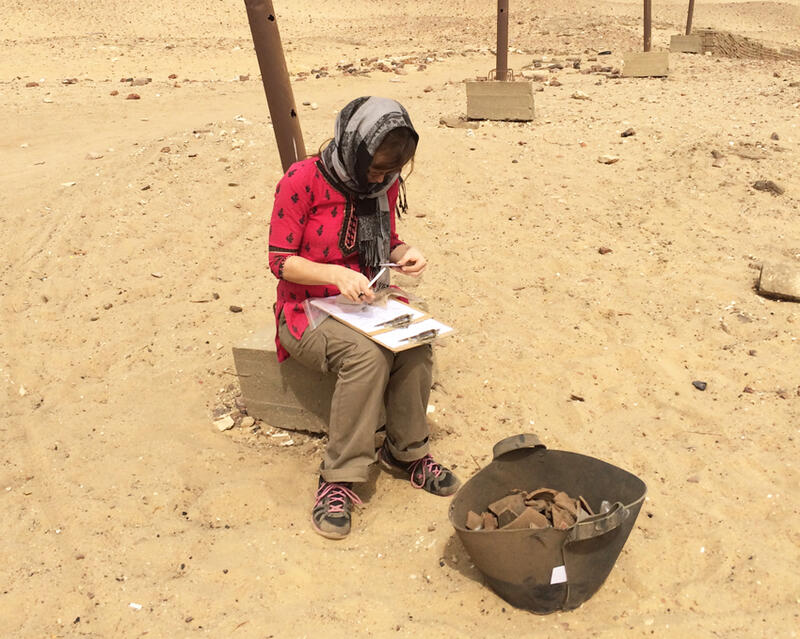
Figure 5. Stéphanie Machabée updating the finds list with newly discovered pottery and objects during the excavation of the Six-Pillared Hall in 2017.
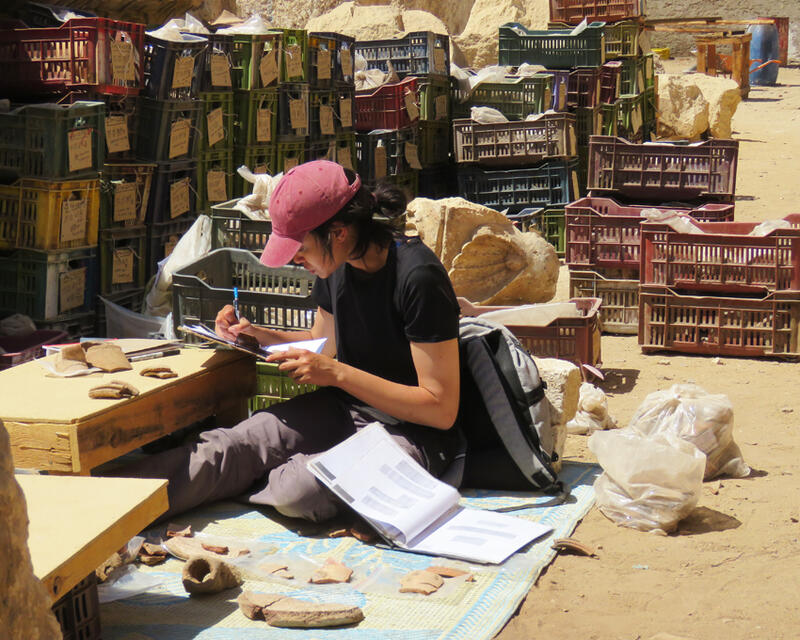
Figure 6. Andrea Achi recording pottery from the excavation of the Six-Pillared Hall in 2019.
The identification and quantification of plant and animal species can also supply a wealth of economic and environmental information.[10] Those associated with cooking, food storage, and refuse disposal help to reconstruct aspects of food economy such as local and traded ingredients and their processing and/or storage, preparation techniques and cooking styles, and potentially culinary tastes and food restrictions. The presence of domestic and wild species can also speak to local environmental conditions, such as temperature range and precipitation, soil types, water resources, agricultural practices, and wildlife.
Epigraphic and papyrological study of Coptic texts found in situ (i.e. in their original position) has provided a uniquely direct access to Atripe’s early Christian community (fig. 7).[11] Epigraphy is the study of ancient texts inscribed or written on hard surfaces such as stone or plastered walls; papyrology includes the study of writing not only on sheets of papyrus (i.e. papyri), but also on pottery sherds (i.e. ostraca) and other media (animal skins, paper, bones, etc.).[12] The study of such texts involves transcription and translation, as well as the analysis of handwriting, writing technologies (i.e. support material, pigment, organization), and factors related to context and location (i.e. type of space, position, proximity to other texts). Such details provide invaluable information about the writers themselves, including their calligraphic experience, the circumstances of their writing, and their intended audience.
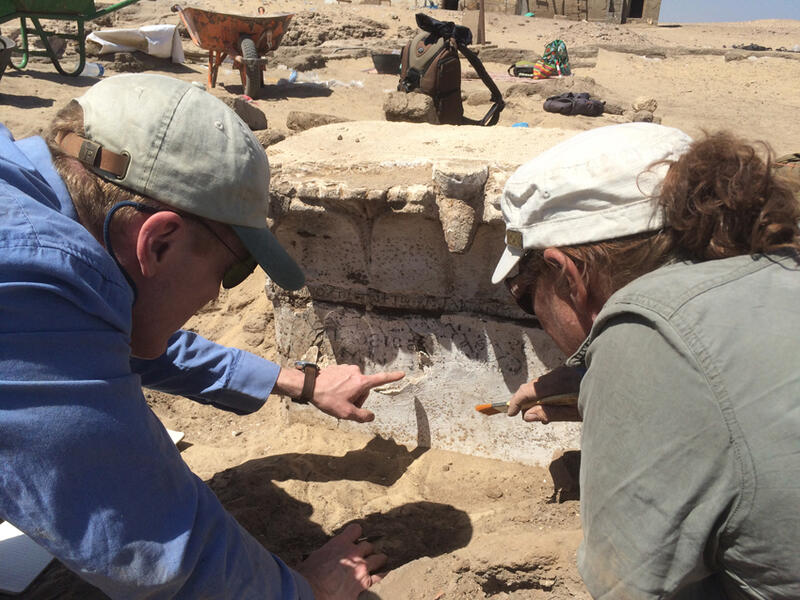
Figure 7. Stephen Davis and Wendy Dolling examining a newly-discovered wall writing in the Six-Pillared Hall in 2017.
[1] For Petrie’s work, see W. M. F. Petrie, Athribis (London: School of Archaeology in Egypt, 1908), 5, 11, pls. XIV and XXXV. For the work of the University of Tübingen expedition, see R. El-Sayed and Y. El-Masry, eds., Athribis I, General Site Survey 2003–2007, Archaeological and Conservation Studies. The Gate of Ptolemy IX: Architecture and Inscriptions (Cairo: Institut français d’archéologie orientale, 2012); and M. Müller, M. El-Bialy, and M. Boriak, eds., Athribis V, Archäologie im Repit-Tempel zu Athribis 2012–2016, ed. M. Müller, M. El-Bialy and M. Boriak (Cairo: Institut français d’archéologie orientale, 2019).
[2] For an introduction to GIS, see P. A. Longley, M. F. Goodchild, D. J. Maguire, and D. W. Rhind, Geographic Information Science and Systems, fourth edition (Hoboken, NJ: John Wiley & Sons, 2015); and I. Heywood, An Introduction to Geographical Information Systems, fourth edition (Upper Saddle River, NJ: Prentice Hall, 2011).
[3] For an introduction to SfM, see J. L. Carrivick, M. W. Smith, and D. J. Quincey, Structure from Motion in the Geosciences (Hoboken, NJ: John Wiley & Sons, 2016); S. Green, A. Bevan, and M. Shapland, “A Comparative Assessment of Structure from Motion Methods for Archaeological Research,” Journal of Archaeological Science 46 (2014), 173–181. For some examples, see M. J. Westoby, J. Brasington, N. F, Glasser, M. J. Hambrey, and J. M. Reynolds, “ʽStructure-from-Motion’ Photogrammetry: A Low-Cost, Effective Tool for Geoscience Applications,” Geomorphology 179 (2012), 300–314; and J. A. B. López, G. A. Jiménez, M. S. Romero, E. A. García, S. F. Martín, A. L. Medina, and J. A. E. Guerrero, “3D Modelling in Archaeology: The Application of Structure from Motion Methods to the Study of the Megalithic Necropolis of Panoria (Granada, Spain),” Journal of Archaeological Science Reports 10 (2016), 495–506.
[4] For DStretch, see: see https://www.dstretch.com/.
[5] Anonymous, Archaeological Site Manual (London: Museum of London Archaeological Service, 1994). See also the online resources at https://www.museumoflondon.org.uk/collections/other-collection-databases-and-libraries/museum-london-archaeological-archive/archaeological-research-resources. Additional resources are available at http://www.bajr.org/BAJRread/BAJRGuides.asp.
[6] L. Blanke, An Archaeology of Egyptian Monasticism: Settlement, Economy and Daily Life at the White Monastery Federation, Yale Egyptological Publications 2 (New Haven: Yale Egyptology, 2018), 63.
[7] For an introduction to the study of ceramics see C. Orton, and M. Hughes, Pottery in Archaeology, second edition (Cambridge: Cambridge University Press, 2013); D. Arnold and J. Bourraiu, An Introduction to Ancient Egyptian Pottery (Deutsches archäologisches Instituts Abteilung Kairo Sonderschrift 17; Mainz am Rhein: Philipp von Zabern, 1993). For an introduction to the study of glass, see K. H. A. Janssens, Modern Methods for Analysing Archaeological and Historical Glass (Hoboken, NJ: Wiley 2013); J. Henderson, Ancient Glass: An Interdisciplinary Exploration, third edition (Cambridge: Cambridge University Press, 2013).
[8] For an introduction to ceramic petrography, see P. S. Quinn, Ceramic Petrography: The Interpretation of Archaeological Pottery and Related Artefacts in Thin Section (Oxford: Archaeopress, 2013); I. S. Druc, M. A. Masucci, and M. F. Ownby, eds., Integrative Approaches in Ceramic Petrography (Salt Lake City: University of Utah Press, 2017); M. F. Ownby, “Petrographic Analysis of Egyptian Ceramic Fabrics in the Vienna System,” in Vienna 2 – Ancient Egyptian Ceramics in the 21st Century, Proceedings of the International Conference Held at the University of Vienna, 4th-18th of May, 2012, ed. B. Bader, C. M. Knoblauch, and E. C. Köhler (Orientalia Lovaniensia Analecta 245; Leuven: Peeters 2016), 459–460.
[9] For an introduction to the study of objects, see L. Hurcombe, Archaeological Artefacts as Material Culture (Abingdon/New York: Routledge, 2007); B. Olsen, M. Shanks, T. Webmoor, and C. Witmore, Archaeology: The Discipline of Things (Berkeley: University of California Press, 2012). For photography and illustration of objects (including pottery and glass) see L. J. Fisher, Photography for Archaeologists, Part II: Artefact Recording, BAJR Practical Guide Series 26, 2009, published online, available at http://www.bajr.org/BAJRGuides/26.%20Artefact%20Photography%20in%20Archaeology/26ArtefactPhotographyforArchaeologists.pdf; and T. Small, Archaeological Illustration: Small Finds, BAJR Practical Guide Series 32, 2013, published online, available at http://www.bajr.org/BAJRGuides/32.%20Archaeological%20Illustration%20-%20Small%20Finds/Guide32.pdf.
[10] For an introduction to archaeobotanical remains at late antique monastic sites in Egypt, see W. Smith, Archaeobotanical Investigations of Agriculture at Late Antique Kom el-Nana (Tell el-Amarna), Egypt Exploration Society Excavation Memoir 70, London: Egypt Exploration Society, 2003. For an introduction to aspects of zooarchaeology, see: A. M. Biesaw, Identifying and Interpreting Animal Bones: A Manual, College Station: Texas A&M University Press, 2013; S. Ikram, Choice Cuts: Meat Production in Ancient Egypt, Orientalia Loveniensia Analecta 69, Leuven: Peeters, 1995; H. Russ, Introduction to Archaeological Fish Remains, BAJR Practical Guide Series 29, 2009, published online, available at http://www.bajr.org/BAJRGuides/29.Introduction%20to%20archaeological%20f….
[11] For a more detailed report on the results of this epigraphic study, see Stephen J. Davis, “Anastasia, Thecla, and Friends: Archaeological and Epigraphic Evidence from the Shenoutean Women’s Monastery at Atripe,” Le Muséon 133.3–4 (2020), 259–287.
[12] For guides to the textual and historical study of such documentary sources, see P. W. Pestman, The New Papyrological Primer, second edition revised, ed. M. Davis, B. A. Van Groningen, and P. W. Pestman (Leiden: E. J. Brill, 1994); and R. S. Bagnall, Reading Papyri, Writing Ancient History, second edition (Abingdon and New York: Routledge, 2020).
